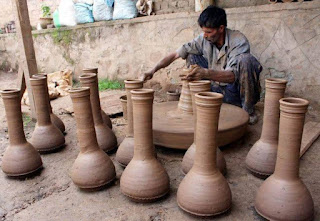( Darbuka)
( Tumbaknaari making )
( Tumbaknaari)
( Tambourine)
TUMBAKNAARI ,THE POPULAR PERCUSSION INSTRUMENT OF KASHMIR..
A pottery shopkeeper in Moti Bazar Jammu told me this :-
“ Pottery market is declining everyday. Apart from steel, people are buying pots and utensils made from plastic and metals like stainless steel and aluminium. Now our sale is confined to rituals connected with deaths , marriages and other religious functions. Lool , this traditional water Surahi has no buyer now. These Diyas or lamps are sold on Deepawali only. Yes Kashmiri Pandits are our new customers .Kashmiri Pandit marriage ceremony has made Jammu potters innovative . They have mastered the technique of making the widely used percussion instrument known as Tumbaknaari . One marriage means a demand of 6 to 8 Tumbaknaaris . These are also carried to far off cities like Mumbai, Delhi Jaipur and even Bangaluru by them. It makes Mehndiraat singing entertaining. Some Kashmiri Pandits told me that they use it for evening singing even a month before the Mehndiraat or after the auspicious Muhurat is declared by their family priest. You must be knowing better.
It sells like anything during marriages .In fact we have heavy demand for Tumbaknaaris during kashmiri Pandit Marriage season.”
What is the source of Tumbaknaari ?
A Tumbaknaari comes close to Tonbak , Tambourine , Daff, Egyptian Darbuka . All these instruments have wooden or earthen or metallic shell which is covered from one side ( that is wider) with leather or synthetic material . Generally sheepskin or goatskin is stretched and secured with glue.The other side that is not wide is kept open. Tonbak is an essential percussion instrument used by Kurdish musicians . In many European paintings on display inside Metropolitan Museum of Art ,New York, I have seen a Tonbak type musical instruments. The tambourine is a popular hand-held instrument that is often played by a number of members of any given Gospel choir in the church. I have seen a Tonbak type instrument being played by people performing traditional Brazilian music for Samba, Choro, Coco, or Capoeira. Did the Portuguese carry it to Latin America? I have seen the traditional and ancient percussion instrument of Konkan region of India known as Gomutt. Made of clay and animal skin, a Gomutt is version of Tumbaknaari .
The Tonbak (also called Zarb, the Persian goblet drum) and the Daf (the Kurdish frame drum) are the only national drums of Persia. Also the presence of goblet drums in Asia, North Africa and East Europe shows the importance of this class of drums. Unfortunately, the origin of the Tonbak is still in dispute.During the Pre-Islamic age in Persia, the tonbak was known as the dombalag. Today, the names that the tonbak is known by ( tonbak, donbak, dombak) are possibly derived from dombalag only.
The origin of the tambourine is unknown, but it appears in historical writings as early as 1700 BC and was used by ancient musicians in West Africa, the Middle East, Greece and India. It is believed that the tambourine passed to Europe by way of merchants or musicians.
A Dafli or Daff is a handheld bass producing device, which can be thought of similar to a drum or Tabla. There is not much learning involved unlike other musical instruments and one can soon learn to produce a musical pattern on it. They are often used in rural folk fares, religious festivals, or Bhajans.Daff or Dafli has also been used by Sufis.
Darbuka is a Percussion made of a wooden shell (presently aluminium) with a leather head ( presently synthetic) . As drum, it gives deep low notes as well as ringing highs .It has a tunable and replaceable synthetic head . Darbuka is a modified version of Tumbaknaari . Darbuka was and is s popular percussion instrument used by Armenians and Turks.
Is Tumbaknaari a version of Pataha ,the percussion instrument used in ancient Kashmir? I have found two more musical instruments of ancient Kashmir that bear close proximity to Tumbaknaari.
The Nilamata Purana makes mention of Pataha .It is a sort of drum that was used as a musical instrument in ancient Kashmir.
The Nilamata Purana says ,' The land of Kaśmīra was thronged with ever-sportive and joyful people enjoying continuous festivities. Living amidst scenes of sylvan beauty they played, danced and sang to express their joys, to mitigate their pains, to please their gods and to appease their demons'. Pataha finds mention in Ramayana and Mahabharata . It is believed that the Pataha was played upon generally in accompaniment to the lute. The Shivapurana makes mention of Pataha .Paṭaha ia also mentioned in Natya Shastra . Lord Shiva is believed to have danced on the beats of Pataha .
Isn't Tumbaknaari a universal percussion instrument ? Whether Tumbaknaari is an indigenous musical instrument of Kashmir or it has come from Persia , one can't say conclusively. It needs research . There are also reasonable grounds to believe that this percussion instrument has travelled to Europe and the world through the ancient silk route .
( Avtar Mota)
 CHINAR SHADE
CHINAR SHADE by
Autarmota is licensed under a
Creative Commons Attribution-Noncommercial-No Derivative Works 2.5 India License.
Based on a work at
http:\\autarmota.blogspot.com\.



.jpeg)
.jpeg)
No comments:
Post a Comment
Note: Only a member of this blog may post a comment.